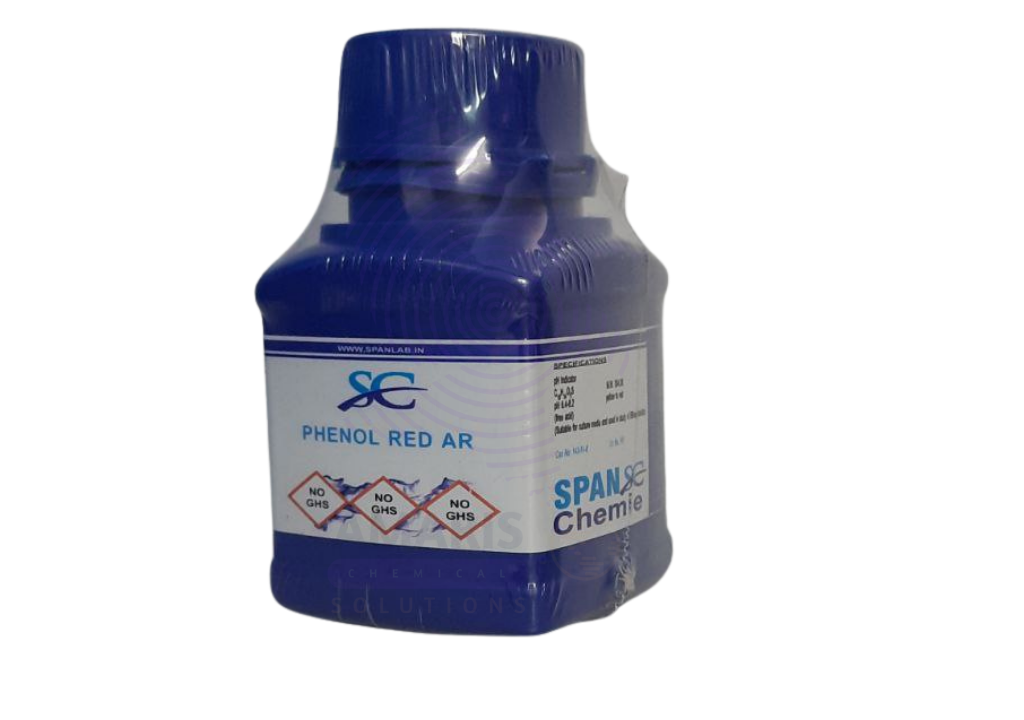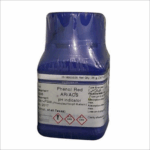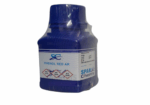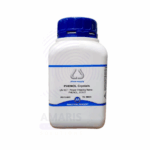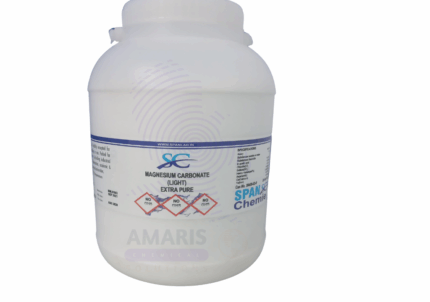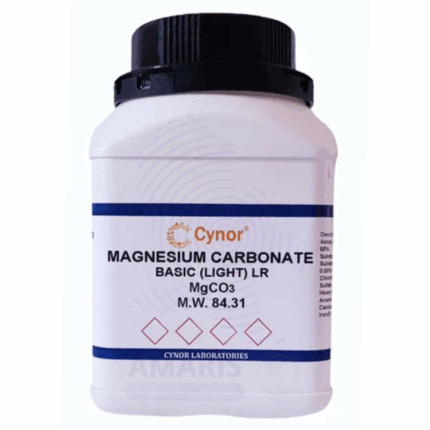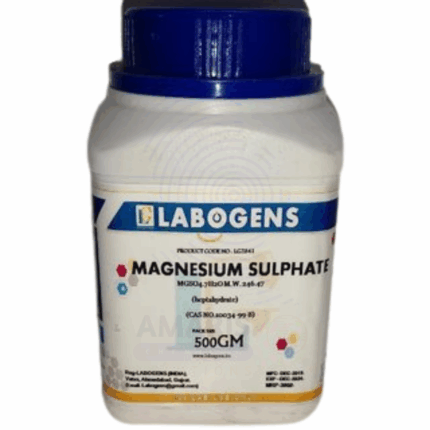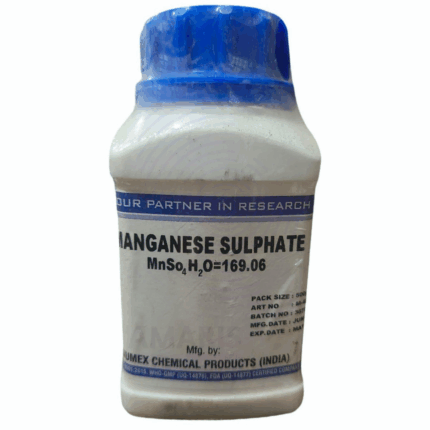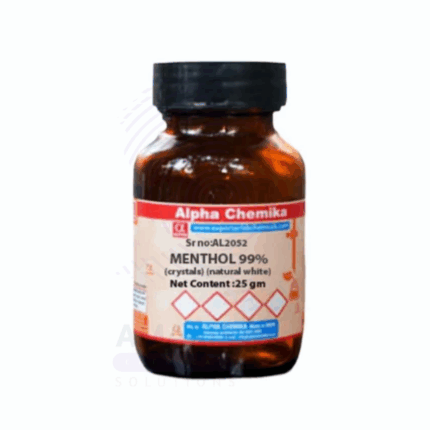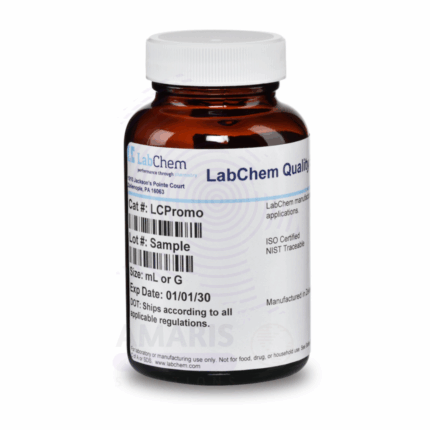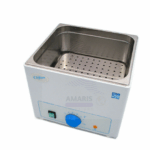
Phenol Red Extra Pure
$ 17.20
Phenol Red Extra Pure is a highly refined pH indicator dye widely used in biological and chemical laboratories. Appearing as a reddish crystalline powder, it changes color based on pH—yellow in acidic environments (pH < 6.8), red in neutral to slightly basic conditions (around pH 7.4), and fuchsia in more alkaline solutions (pH > 8.2).
This Extra Pure grade is particularly suited for cell culture media, where it helps monitor pH fluctuations during cell growth and metabolic activity. It is also employed in analytical chemistry, water quality testing, and titrations. Phenol Red is stable under normal storage conditions but should be kept in a dry, tightly sealed container away from strong acids or bases. Proper lab safety protocols—such as wearing gloves and goggles—are recommended when handling the powder or concentrated solutions.
Phenol Red Extra Pure
PRIMARY USES
- Serves as a pH indicator in cell culture media, showing color changes from yellow (acidic) to red (neutral) to fuchsia (alkaline).
- Widely used in microbiology and biochemistry to monitor pH changes due to microbial activity.
- Integral component in cell and tissue culture, helping detect contamination and metabolic activity.
- Utilized in aquarium and pool water testing kits to measure pH levels.
- Applied in clinical diagnostics, especially in phenol red thread tests for eye tear production.
SECONDARY USES
- Employed in educational labs for demonstrating acid-base reactions and pH scales.
- Occasionally used in urine analysis kits as a pH indicator.
- Used in formulation of test kits for enzymes or bacteria that alter pH in solution.
- Functions as a colorimetric marker in various experimental protocols.
- May be used in toxicology studies as a tracer to observe chemical exposure effects in cultures.
1. Basic Identification Attributes
- Chemical Name: Phenol Red
- CAS Number: 143-74-8
- HS Code: 3822.00.00
- Molecular Formula: C₁₉H₁₄O₅S
- Synonyms:
- Phenolsulfonphthalein
- PSP
- Sulfonphthalein
- C.I. 45350
2. Physical & Chemical Properties
- Physical State: Solid (powder or crystalline form)
- Color & Odor: Reddish to dark purple powder; odorless
- Boiling Point: Decomposes before boiling
- Melting Point: ~280 °C (with decomposition)
- Density: ~1.36 g/cm³
- Solubility:
- Slightly soluble in water
- Soluble in alcohol and alkaline solutions
- pH Range (Indicator Use):
- Yellow at pH < 6.4
- Red at pH > 8.2
- Vapor Pressure: Negligible
- Flash Point: Not applicable (non-flammable solid)
- Autoignition Temperature: Not readily available
- Viscosity: Not applicable
3. Safety & Hazard Attributes
- Hazard Class (GHS Classification):
- Not classified as hazardous under GHS for general lab use
- May cause mild irritation to skin or eyes with prolonged contact
- NFPA Ratings:
- Health: 1
- Flammability: 1
- Reactivity: 0
- Exposure Limits: Not established (low toxicity)
- Reactivity:
- Stable under normal conditions
- Incompatible with strong oxidizing agents
4. Storage & Handling Attributes
- Storage Conditions:
- Store in a cool, dry, and well-ventilated place
- Avoid moisture and direct sunlight
- Incompatible Materials:
- Strong oxidizers and strong acids
- Container Type: Tightly sealed plastic or glass containers
- Shelf Life & Expiration Date: 2–3 years under proper storage
- Special Handling Requirements:
- Use gloves and protective eyewear
- Avoid inhalation of dust
5. Regulatory & Compliance Attributes
- Regulatory Status:
- Listed under TSCA and REACH
- Not considered a hazardous chemical under OSHA regulations
- Transportation Restrictions:
- Not classified as hazardous for transport
- Waste Disposal Method:
- Dispose of in accordance with local, regional, and national regulations
- Dilute solutions may be disposed via standard wastewater (verify with local authority)
6. Environmental & Health Impact
- Ecotoxicity:
- Low toxicity to aquatic life in small quantities
- Persistence in Environment:
- Degradable, but specific rates vary with environmental conditions
- Carcinogenicity/Mutagenicity:
- Not listed as carcinogenic or mutagenic by IARC or OSHA
- Biodegradability:
- Generally considered biodegradable in natural conditions
SAFETY PRECAUTIONS
Personal Protective Equipment (PPE):
- Wear lab coats, chemical-resistant gloves (e.g., nitrile), and protective safety goggles.
- Use a dust mask or work in a fume hood to avoid inhalation of fine particles.
Handling:
- Avoid contact with skin, eyes, and clothing.
- Prevent dust formation and avoid breathing dust.
- Wash hands thoroughly after handling.
Storage:
- Store in a tightly sealed container in a cool, dry, and well-ventilated area.
- Protect from direct sunlight and moisture.
- Keep away from strong oxidizing agents.
FIRST AID MEASURES
Inhalation:
- Move the person to fresh air.
- Seek medical attention if symptoms such as coughing or difficulty breathing occur.
Skin Contact:
- Wash affected areas with plenty of water and soap.
- Remove contaminated clothing.
- Seek medical advice if irritation develops.
Eye Contact:
- Rinse immediately with plenty of water for several minutes.
- Remove contact lenses if it is easy to do so.
- Continue rinsing and seek medical attention if irritation persists.
Ingestion:
- Rinse mouth with water.
- Do not induce vomiting.
- Seek medical attention if symptoms occur.
FIRE FIGHTING MEASURES
Flammability:
- Not highly flammable but can burn if involved in fire.
Extinguishing Media:
- Use dry chemicals, CO₂, or foam.
- Water spray can be used to cool exposed containers.
Hazardous Combustion Products:
- May release carbon monoxide, carbon dioxide, and sulfur oxides upon combustion.
Firefighter Protection:
- Wear full protective gear and self-contained breathing apparatus (SCBA).
- Avoid inhaling combustion fumes.


 Preservatives(food)
Preservatives(food) Flavor Enhancers
Flavor Enhancers Acidulants
Acidulants Sweeteners
Sweeteners Antioxidants
Antioxidants Colorants(food)
Colorants(food) Nutraceutical Ingredients (food)
Nutraceutical Ingredients (food) Nutrient Supplements
Nutrient Supplements Emulsifiers
Emulsifiers
 Collectors
Collectors Dust Suppressants
Dust Suppressants Explosives and Blasting Agents
Explosives and Blasting Agents Flocculants and Coagulants
Flocculants and Coagulants Frothers
Frothers Leaching Agents
Leaching Agents pH Modifiers
pH Modifiers Precious Metal Extraction Agents
Precious Metal Extraction Agents
 Antioxidants(plastic)
Antioxidants(plastic) Colorants (Pigments, Dyes)
Colorants (Pigments, Dyes) Fillers and Reinforcements
Fillers and Reinforcements Flame Retardants
Flame Retardants Monomers
Monomers Plasticizers
Plasticizers Polymerization Initiators
Polymerization Initiators Stabilizers (UV, Heat)
Stabilizers (UV, Heat)
 Antifoaming Agents
Antifoaming Agents Chelating Agents
Chelating Agents Coagulants and Flocculants
Coagulants and Flocculants Corrosion Inhibitors
Corrosion Inhibitors Disinfectants and Biocides
Disinfectants and Biocides Oxidizing Agents
Oxidizing Agents pH Adjusters
pH Adjusters Scale Inhibitors( water)
Scale Inhibitors( water)
 Antioxidants(cosmetic)
Antioxidants(cosmetic) Emollients
Emollients Fragrances and Essential Oils
Fragrances and Essential Oils Humectants
Humectants Preservatives
Preservatives Surfactants(cosmetic)
Surfactants(cosmetic) Thickeners
Thickeners UV Filters
UV Filters
 Fertilizers
Fertilizers Soil Conditioners
Soil Conditioners Plant Growth Regulators
Plant Growth Regulators Animal Feed Additives
Animal Feed Additives Biostimulants
Biostimulants Pesticides (Herbicides, Insecticides, Fungicides)
Pesticides (Herbicides, Insecticides, Fungicides)
 Active Pharmaceutical Ingredients (APIs)
Active Pharmaceutical Ingredients (APIs) Excipients
Excipients Solvents(pharmaceutical)
Solvents(pharmaceutical) Antibiotics
Antibiotics Antiseptics and Disinfectants
Antiseptics and Disinfectants Vaccine Adjuvants
Vaccine Adjuvants Nutraceutical Ingredients (pharmaceutical)
Nutraceutical Ingredients (pharmaceutical) Analgesics & Antipyretics
Analgesics & Antipyretics
 Analytical Reagents
Analytical Reagents Solvents(lab)
Solvents(lab) Chromatography Chemicals
Chromatography Chemicals Spectroscopy Reagents
Spectroscopy Reagents microbiology-and-cell-culture-reagents
microbiology-and-cell-culture-reagents Molecular Biology Reagents
Molecular Biology Reagents Biochemical Reagents
Biochemical Reagents Inorganic and Organic Standards
Inorganic and Organic Standards Laboratory Safety Chemicals
Laboratory Safety Chemicals Specialty Laboratory Chemicals(Special Laboratory Equipment)
Specialty Laboratory Chemicals(Special Laboratory Equipment)
 Demulsifiers
Demulsifiers Hydraulic Fracturing Fluids
Hydraulic Fracturing Fluids Scale Inhibitors(oil)
Scale Inhibitors(oil) Surfactants(oil)
Surfactants(oil) Drilling Fluids
Drilling Fluids
 Dyes and Pigments
Dyes and Pigments Bleaching Agents
Bleaching Agents Softening Agents
Softening Agents Finishing Agents
Finishing Agents Antistatic Agents
Antistatic Agents
 Admixtures
Admixtures Waterproofing Agents
Waterproofing Agents Sealants and Adhesives
Sealants and Adhesives Curing Compounds
Curing Compounds Concrete Repair Chemicals
Concrete Repair Chemicals Anti-Corrosion Coatings
Anti-Corrosion Coatings
 Surfactants(cleaning)
Surfactants(cleaning) Builders
Builders Enzymes
Enzymes Solvents (Cleaning)
Solvents (Cleaning) Fragrances
Fragrances
 Electronic Chemicals
Electronic Chemicals Catalysts
Catalysts Lubricants
Lubricants Photographic Chemicals
Photographic Chemicals Refrigerants
Refrigerants Automotive chemicals
Automotive chemicals Pyrotechnic Chemicals
Pyrotechnic Chemicals
 Biodegradable Surfactants
Biodegradable Surfactants Bio-based Solvents
Bio-based Solvents Renewable Polymers
Renewable Polymers Carbon Capture Chemicals
Carbon Capture Chemicals Wastewater Treatment Chemicals
Wastewater Treatment Chemicals
 Pigments
Pigments Solvents(paint)
Solvents(paint) Specialty Coatings
Specialty Coatings Binders/Resins
Binders/Resins Additives
Additives Driers
Driers Anti-Corrosion Agents
Anti-Corrosion Agents Functional Coatings
Functional Coatings Application-Specific Coatings
Application-Specific Coatings
 Fresh Herbs
Fresh Herbs Ground Spices
Ground Spices Whole Spices
Whole Spices Spice Blends
Spice Blends Dried Herbs
Dried Herbs
 Leavening Agents
Leavening Agents Dough Conditioners
Dough Conditioners Flour Treatments
Flour Treatments Fat Replacers
Fat Replacers Decoratives
Decoratives Preservatives(baking)
Preservatives(baking)
 Plasticizers & Softeners
Plasticizers & Softeners Reinforcing Agents
Reinforcing Agents Adhesion Promoters
Adhesion Promoters Vulcanizing Agents
Vulcanizing Agents Antidegradants
Antidegradants Blowing Agents
Blowing Agents Fillers & Extenders
Fillers & Extenders Accelerators & Retarders
Accelerators & Retarders
